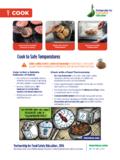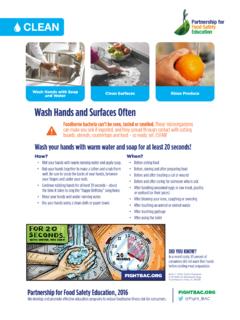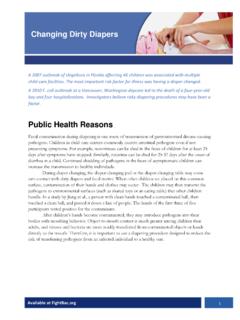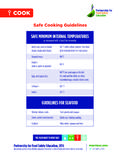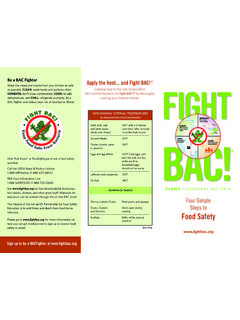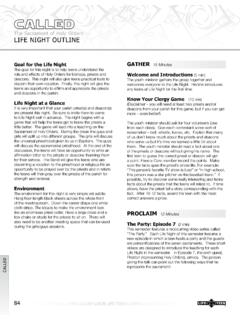Transcription of Your Fresh Fruits and Vegetables - Fight Bac!
1 1 Educator Presentation your Fresh Fruits and Vegetables Safe Handling of Fresh Fruits and Vegetables 2 Presentation Purpose Introduce you to a new consumer education campaign from Highlight issues related to educating consumers on safe food handling. Provide tools and messages to support your health education efforts. 3 The Partnership for Food Safety Education A non-profit joining government, industry and scientific experts in supporting consumer education. Creator and steward of Fight BAC! and science-based home food safety messages. Creator of Fight BAC! ProducePro messages on enjoying safe Fresh Fruits and Vegetables .
2 A partner to health and food safety educators across the ! 4 Presentation Outline What do we know about foodborne illness? Why is education important? What will help reduce risk? What can you do? 5 What do we know about foodborne illness? The US food supply is one of the safest in the world. However, food poisoning affects 1 in 6 Americans each year. Fresh Fruits and Vegetables are necessary for a healthy diet and can be a source of foodborne pathogens. Along with encouraging consumers to eat more Fresh Fruits and Vegetables , we must provide them with messages on hand hygiene and safe handling to reduce risk of food poisoning.
3 6 Who gets food poisoning? Few consumers think home is source of food contamination 8% (FMI 2011) Almost of the entire US population is at increased risk for illness: Over age 65 Less than 5 years old Kids under 4 years old are times more likely to acquire bacterial infections from food compared to adults. Pregnant women Immunocompromised 7 Presentation Outline What do we know about foodborne illness? Why is education important? What will help reduce risk? What can you do? 8 Source: CDC 9 Consumer Education is KEY! Food handling at home is the last step in the food safety chain of prevention.
4 Regardless of quality of safeguards before food reaches the consumer, food can be contaminated at the point of handling and preparation at home. Consumer food handling behaviors are recognized in Healthy People 2020 goals. 11 Consumer Perceptions and Behavior in Handling Fresh Produce: US Consumers who think it is likely that Fruits and Vegetables have germs that could make them sick (2010 FDA Food Safety Survey): 12 Consumers believe food safety is important and agree that foodborne illness is a serious health threat. Consumers Care About Food Safety Source: The Partnership for Food Safety Education 13 Presentation Outline What do we know about foodborne illness?
5 Why is education important? What will help reduce risk? What can you do? 14 Fight BAC! with 6 smart produce-handling practies! What can be done to reduce risk? Check Clean Rinse Separate Chill Throw Away 15 Built on scientific evidence and reviewed by scientific experts. Communicates 6 simple produce-handling practices for consumers at home. Graphics and turn-key materials for health educators and food retailers. Supported with social media outreach by Fight BAC! Tested with experts. 16 Don t Forget! Recommendations should be communicated in their entirety.
6 Summarize verbally, but use messages exactly as provided when appearing in print Remind consumers that thorough and consistent use of the 6 Smart Practices will help them reduce risk of foodborne illness to themselves and their family members. 17 Become a ProducePro These new, colorful and approachable FREE materials help you teach smart home produce-handling practices. Share the 6 Smart Produce-Handling Tips! 18 Six Smart Tips for Safer Fruits & Vegetables Food safety is critical, especially to the health of our kids and seniors. That s why Fight BAC! Developed the evidence-based information you need to spread the word about fighting harmful foodborne bacteria.
7 Ellie Krieger, Registered dietitian and TV personality 19 Check that the Fresh Fruits and Vegetables you buy are not bruised or damaged. Bruising or cuts make a piece of fruit more susceptible to growth of microbes that can cause illness. But remember, you cannot see, smell or taste the bacteria that can cause food poisoning. When choosing pre-cut Fruits and Vegetables like packaged salads and sliced melons, check that the product is refrigerated or on ice. Bacteria grow most rapidly in the range 40 F - 140 F, doubling in number in as little as 20 minutes. This range of temperatures is often called the Danger Zone.
8 What To Do Why 20 Wash hands with warm water and soap for at least 20 seconds before and after handling Fresh Fruits and Vegetables . Bacteria from unwashed hands can get into foods and drinks while people prepare or consume them. Clean all surfaces and utensils with hot water and soap, including cutting boards and knives, before and after preparing Fresh Fruits and Vegetables . Germs can multiply rapidly under certain conditions and make people sick. The CDC recommends this hand washing practice to reduce illnesses and the spread of infections to others. What To Do Why 21 Just before use, rinse under running water only the Fruits and Vegetables you plan to eat, including those with skins or rinds that are not eaten.
9 Evidence shows that washing Vegetables and fruit by running water over them is associated with reduced microbial loads. Firm-skinned Fruits and Vegetables should be rubbed by hand or scrubbed with a clean brush while rinsing under running tap water. Researchers found that when cantaloupe and honeydew melons were scrubbed with a clean brush under running water, optimal microbial removal was achieved. What To Do Why Packaged Fruits and Vegetables labeled ready-to-eat, washed or triple washed should not be washed. It is also recommended that consumers clean and sanitize brushes to prevent possible cross-contamination.
10 22 Dry Fruits and Vegetables with a clean cloth or paper towel. A panel of scientists with expertise in microbial safety of Fresh produce concluded that additional washing of ready-to-eat green salads is not likely to enhance safety and may increase the potential of cross-contamination. Do not use soap or bleach to wash Fresh Fruits or Vegetables . These products are not intended for consumption. Research shows that patting dry with paper or clean cloth towel will further help reduce bacterial loads. What To Do Why Researchers found that running water was just as effective as any veggie washes, vinegar solutions or detergents in getting rid of bacteria.

